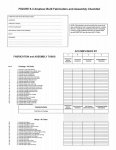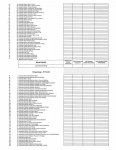gyrogreg
Senior Member
- Joined
- Dec 9, 2003
- Messages
- 1,000
- Location
- Ste. Genevieve, Missouri, USA
- Aircraft
- Magni M-16 Gyroplane
- Total Flight Time
- 3000 total, 2000 Gyro
I'm not sure the rotorcraft community is aware that the FAA has proposed changes the Experimental Amateur Built (E-AB, 51%) criteria. The proposed changes can severely affect the advances in sport rotorcraft safety and technology that have been made in recent years:
The Docket number is FAA-2008-0823-0001. The change is to REQUIRE that at least 20% of the FABRICATION be accomplished by the builder. This presents difficulties for other aircraft types, such as the "glass" airplanes from Europe. The EAA had argued against these changes, for some of the same reasons I outline below, but the FAA has moved on with these proposed changes anyway!!!!
The docket is currently open for comments - but only until the end of September!! I believe we urgently need the Experimental Rotorcraft community to respond. I believe the impact on experimental rotorcraft has even more severe consequences than a lot of what the EAA is arguing for airplanes is.
The main issue is that it is very difficult to find at least 20% of the FABRICATION of an experimental rotorcraft KIT that the factories are willing to allow the builder to fabricate. (The rule also proposes that at least 20% of the ASSEMBLY be accomplished by the builder. For the kits I've considered with the proposed 51% checklist, the ASSEMBLY is not a problem - easily more than 51% of the ASSEMBLY is done by the builder. But, the story is much different for rotorcraft kits on the FABRICATION percent by builder!)
Rotorcraft, gyros and helos, have very few components that do not require precision, skilled and reliably fabricated parts. (Traditional airplanes have wings and empennage, etc. that can more easily and safely be fabricated by builders. Even some of the new high-tech composite airplanes do not lend themselves very well to even 20% builder fabrication!)
Many of the available gyroplane and helicopter kits were designed to be fully-built in a factory with skilled and precise fabrication to make the assembly cost effective and safe. That means that components are engineered for precision fit with careful control of weight and strength, etc. For these aircraft producers, especially from foreign factories where KITS are not required, probably including Magni, Xenon, ELA and MT03, it would probably not be practical to "down-design" kit components that would allow for less precise and possibly less reliable components to be fabricated by a builder – just to satisfy this 20% fabrication requirement in the U.S. The U.S. is the only country whose rules REQUIRE that sport rotorcraft be built under these rules - cannot be purchased fully-built! I'm not even sure that some American kit gyros, such as Air Command and Sport Copter could qualify for the 20% fabrication! If this rule goes through, it may set back the sport rotorcraft industry and safety in America more than a decade! The FAA Rotorcraft Directorate on the other hand (that doesn’t talk to the other hand) has commented that they are encouraged by the developments they are seeing in sport gyroplanes – the SH, Magni, Xenon, etc. These recognized advances would be stopped dead if these important kits were no longer available in the U.S., at least not in their mature and safely fabricated form!
To make matters worse, the FAA does not consider this change to be a RULES change - it was purposefully not published on the normal REGULATIONS.gov comment website. It is even difficult to find documents that detail what the FAA is proposing. Attached here are four pages of the new proposed 51% checklist. Also attached on the second post is the summary of the FAA proposal – not easily available otherwise! I consider must be reviewed to even realize the impacts of the proposed change - not available easily on the web or anywhere else!!!!
The following posts are comments that I have made to the FAA. Until I brought the REGULATIONS.gov comment website to the attention of FAA coordinator Miguel Vasconcelelos, he was not even aware that the proposec changes were even posted on regulations.gov!! Comments MUST be emailed to [email protected]
If you agree with my concerns about the impact on availablility and safety, I hope you will compile your own comment and send it to the FAA ([email protected])
[I apologize for the resolution of the attachments - it is difficult to convert the FAA doc to a size that can be attached to the forum.]
- Greg Gremminger
The Docket number is FAA-2008-0823-0001. The change is to REQUIRE that at least 20% of the FABRICATION be accomplished by the builder. This presents difficulties for other aircraft types, such as the "glass" airplanes from Europe. The EAA had argued against these changes, for some of the same reasons I outline below, but the FAA has moved on with these proposed changes anyway!!!!
The docket is currently open for comments - but only until the end of September!! I believe we urgently need the Experimental Rotorcraft community to respond. I believe the impact on experimental rotorcraft has even more severe consequences than a lot of what the EAA is arguing for airplanes is.
The main issue is that it is very difficult to find at least 20% of the FABRICATION of an experimental rotorcraft KIT that the factories are willing to allow the builder to fabricate. (The rule also proposes that at least 20% of the ASSEMBLY be accomplished by the builder. For the kits I've considered with the proposed 51% checklist, the ASSEMBLY is not a problem - easily more than 51% of the ASSEMBLY is done by the builder. But, the story is much different for rotorcraft kits on the FABRICATION percent by builder!)
Rotorcraft, gyros and helos, have very few components that do not require precision, skilled and reliably fabricated parts. (Traditional airplanes have wings and empennage, etc. that can more easily and safely be fabricated by builders. Even some of the new high-tech composite airplanes do not lend themselves very well to even 20% builder fabrication!)
Many of the available gyroplane and helicopter kits were designed to be fully-built in a factory with skilled and precise fabrication to make the assembly cost effective and safe. That means that components are engineered for precision fit with careful control of weight and strength, etc. For these aircraft producers, especially from foreign factories where KITS are not required, probably including Magni, Xenon, ELA and MT03, it would probably not be practical to "down-design" kit components that would allow for less precise and possibly less reliable components to be fabricated by a builder – just to satisfy this 20% fabrication requirement in the U.S. The U.S. is the only country whose rules REQUIRE that sport rotorcraft be built under these rules - cannot be purchased fully-built! I'm not even sure that some American kit gyros, such as Air Command and Sport Copter could qualify for the 20% fabrication! If this rule goes through, it may set back the sport rotorcraft industry and safety in America more than a decade! The FAA Rotorcraft Directorate on the other hand (that doesn’t talk to the other hand) has commented that they are encouraged by the developments they are seeing in sport gyroplanes – the SH, Magni, Xenon, etc. These recognized advances would be stopped dead if these important kits were no longer available in the U.S., at least not in their mature and safely fabricated form!
To make matters worse, the FAA does not consider this change to be a RULES change - it was purposefully not published on the normal REGULATIONS.gov comment website. It is even difficult to find documents that detail what the FAA is proposing. Attached here are four pages of the new proposed 51% checklist. Also attached on the second post is the summary of the FAA proposal – not easily available otherwise! I consider must be reviewed to even realize the impacts of the proposed change - not available easily on the web or anywhere else!!!!
The following posts are comments that I have made to the FAA. Until I brought the REGULATIONS.gov comment website to the attention of FAA coordinator Miguel Vasconcelelos, he was not even aware that the proposec changes were even posted on regulations.gov!! Comments MUST be emailed to [email protected]
If you agree with my concerns about the impact on availablility and safety, I hope you will compile your own comment and send it to the FAA ([email protected])
[I apologize for the resolution of the attachments - it is difficult to convert the FAA doc to a size that can be attached to the forum.]
- Greg Gremminger




